
by Sandra Gulland | Jan 14, 2017 | Adventures of a Writing Life, Resources for Writers, The Shadow Queen, The Writing Process |
{Lovely San Miguel de Allende, where I am right now. A photo by Leah Feldon, it is similar to the view from my writing room.}
Yesterday was a big day for me: I woke at 4:00am, and shortly before 8:00am I emailed my manuscript to my editor and agent. It was Friday 13. I am not superstitious, but that did give me pause.
Some writers are able to write a perfectly good novel in two or three drafts. I am not one of those writers! It takes me years (and years) to uncover the complexities, the depths and the “fall line” of a story. My revision process is extremely slow, in spite of all the techniques I use (i.e. plotting) to try to speed it up. I do hope I’m getting closer.
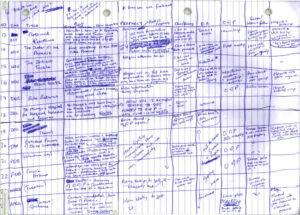
J.K. Rowling’s plot guideline. No doubt it helped!
Moonsick (working title) is my novel for Young Adults, a story based on the teen years of Josephine Bonaparte’s daughter Hortense. Is the novel too giddy? Too dark? I’m frankly not sure. This is why beta readers — teen beta readers — will be important to my final revision process.
Teen beta readers wanted
Later that same day I sent out a newsletter that included a call for teen beta readers. I now have three readers, and (I hope) more to come. I’d also like to find a book club that reads YA fiction — not exclusively, but often enough that they are comfortable with the genre. It occurs to me that a high school English class might be interested in reading it (although it really is a novel for girls). Let me know if you have a teen reader or a book club or class to suggest.
Going back to where it all began
Looking for reader guidelines I’ve used in the past, I discovered a blog post I wrote in February of 2012 — five years ago! — announcing that I would be writing a YA novel about Hortense.
Hortense as a teen — the subject of my next-next novel (Surprise!)
(Note that This Bright Darkness, mentioned in the post, was the working title of The Shadow Queen, which was published two years later, in the spring of 2014.)

Lovely Hortense as a teen. Energetic, creative, talented — a bright spark.
SaveSave
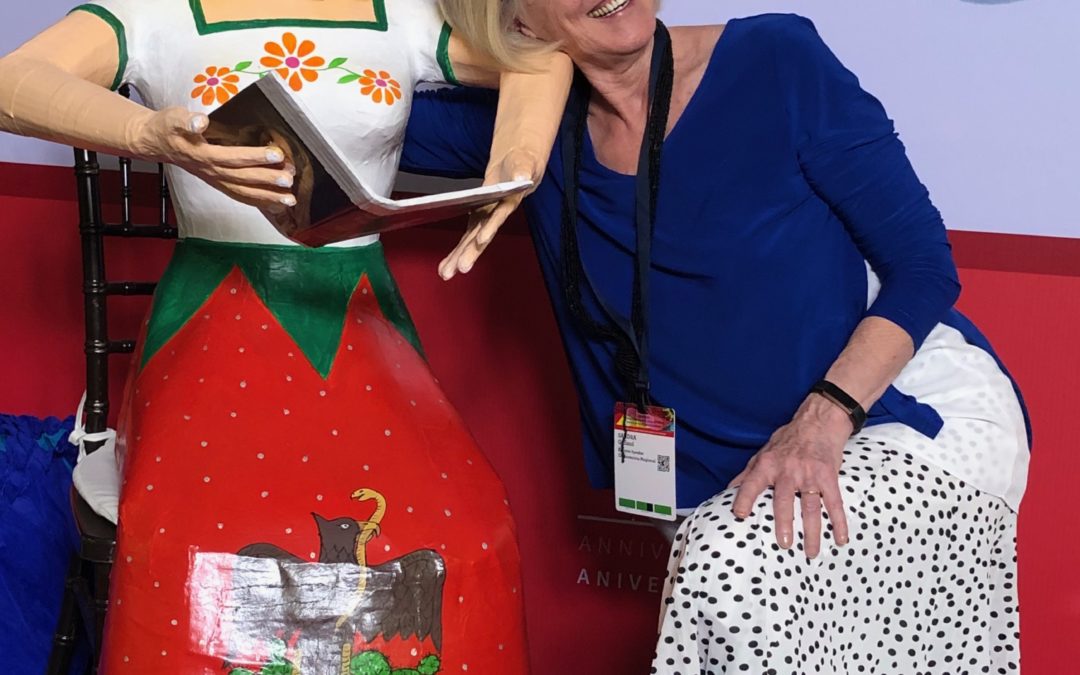
by Sandra Gulland | Jun 30, 2015 | Adventures of a Writing Life |
In one month I’m to give a reading not far from where I live. It’s high time I started preparing. (Did you know that presenters of TED talks prepare for months? For fascinating links on this process: go here.)
An author reading is not a reading: it’s a talk
The first thing to understand about preparing to give a reading is that it should not really be a “reading” at all — it’s best if it’s an engaging talk, with a mere sprinkling of readings thrown in.
Who is in the audience?
Every author needs to be prepared for an audience of 1 or 100. For my event coming up, it’s likely to be a good-sized crowd. A number of those attending will be friends and family.
This raises the bar!
I have given a number of talks in my area over the decades. I want it to go over well, and I don’t want to repeat myself.
That bar just went up several more notches.
Review print-outs and videos of past author readings
I’ve begun preparing for the talk coming up by digging out my earlier speeches. In the process, I discovered a video of a talk I gave about seven years ago. I had just finished a US tour for Mistress of the Sun, and speaking before a crowd daily for weeks on end was great preparation. I also had the advantage of a friend/filmmaker to film this talk, so the recording is without the usual wiggles and jumps.
Decide what to wear
This is a surprisingly important question. At an author reading, people sit and look at you for an hour. I’ve learned not to wear jewelry that can jangle against a mike. Bright is good. Comfortable is great. Fashionable and hip would be nice. Presenting in costume is guaranteed to be a hit.
I often present in historical dress. It’s fun, and everyone enjoys it. However, for me, a question is: Should I wear the same costume I wore the last time I gave a reading at this festival? I think not. A number of people attending will have been at the last one.
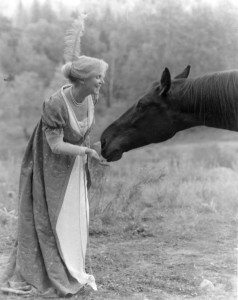
{The photo of me and my horse was taken by Barney McCaffrey.}
I could wear my Josephine gown, which would be relevant to the novel I’m writing now … but not relevant to The Shadow Queen, my latest publication.
Alas, I’m afraid that I should go simply as myself. To tell the truth, I find this somewhat intimidating. It means that content of the talk itself is going to have to be excellent.
Next up: On writing and outlining an author talk. Visuals or not? Give-aways or not?
I’ll keep you posted.
Links of interest
Weekly I’ve started posting links to things I find of interest on the Net. I’m calling it a Sundae of Sundries (posted every Sunday, of course). Let me know if there are any articles or blogs you’d like to share.
The Facts of Life (& Other Mysteries)
I continue to work and rework the WIP, which I’m now calling The Facts of Life (& Other Mysteries). What do you think of that title?
Revision is such slow work. One must be patient and have faith in the process. The work invariably feels broken at this stage.
I was heartened to see this page of revision made by Orwell for 1984. My own pages look similar.
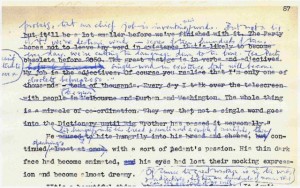
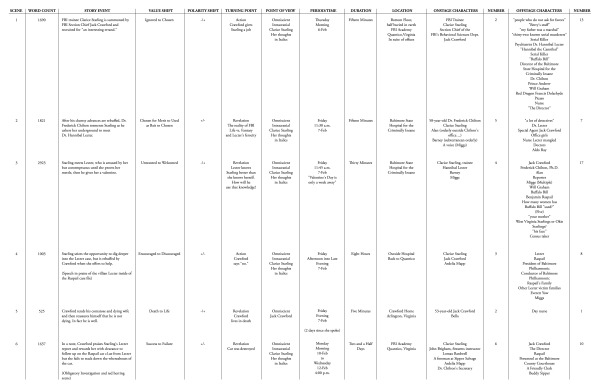
by Sandra Gulland | Apr 20, 2015 | Adventures of a Writing Life, Resources, Resources for Writers, The Writing Process |
My story is missing something, but what? A novel is a complex creature. At some point in the writing process, I find I must closely re-examine the plot in order determine what the story needs.
Editor Shawn Coyne’s The Story Grid method offers excellent tools. (I first wrote about this series here: “The tough nut of revision: on re-examining plot.”)
Seeing your novel on one page will help make story needs clear.
Another basic tool Shawn Coyne offers is the one-page story summary form.
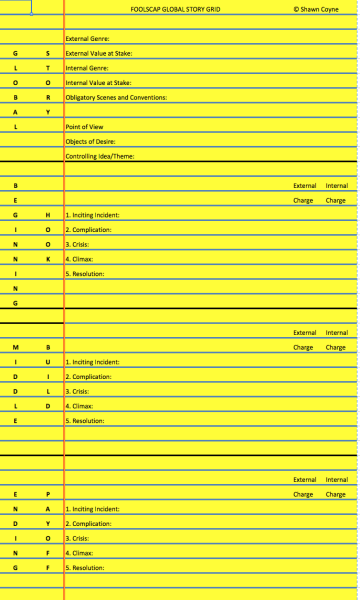
It’s well worthwhile to read his blog series from beginning to end. I’ve highlighted quite a bit. For example:
The crisis is the time when your protagonist must make a decision. And the choice that he makes will determine whether or not he’ll get closer to or further away from his object of desires (both external and internal). Often a particular choice will move a character closer to one object of desire while moving him further away from the other… [
Link]
A detailed scene-by-scene spreadsheet helps reveal what’s needed.
A third visual on the Shawn Coyne’s resource page is an example of a more detailed breakdown of story, using Excel.

I’ve evolved the Excel worksheet concept for my own purposes: I’ve cut columns and added others — what a scene reveals, for example, and another for unanswered questions.
I’ve listed scenes down the left, and themes/sub-plots/plots across the top. This makes it easy for me to see if a thread has been dropped and what needs to be picked up.
I haven’t filled out the worksheet for the entire novel — at least not yet — but it has helped me identify the story needs in the opening scenes, which concerns me the most right now. This process has made me a convert to using Excel for working out a plot.

by Sandra Gulland | Apr 8, 2015 | Adventures of a Writing Life, Resources, Resources for Writers, The Writing Process |
I begin a novel by writing a plot. This doesn’t mean listing actions, but tracing the characters emotional arcs as well. The two are intertwined.
I don’t go into detail: I simply describe a scene in a sentence or two. Even so, it comes to 40 pages, and I take it through several drafts.
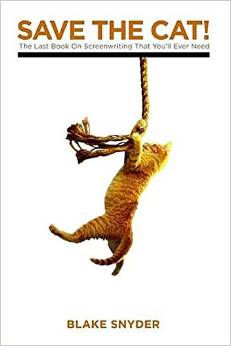
Save the Cat: a great book on plot
I basically use the guidelines Blake Snyder sets out in Save the Cat: they are simple and straightforward.
I’ve condensed them into a “Beat Sheet Guide” for my own use (click to download), but I highly recommend reading the book. Snyder is funny and to-the-point.
I write the first draft quickly, more or less following the scene-by-scene outline I’ve laid out according to these “beats.”
However, somewhere between the first draft and the last (ninth? tenth?), I find I need to regroup. That is: I need to have another look at the structure of the novel—the bones of it.
The (dreaded) middle of the writing process
This is where I am now, struggling to find firm ground in the “swamp” of the fifth draft of my current WIP, The Game of Hope, working title of the first of my Young Adult novels about Hortense.
Many things change in the process of writing. Themes emerge, characters step into the foreground and other characters prove to be ineffectual and need to be cut. New scenes are required, entire chapters.
It’s a confusing stage of the writing process: taking a novel apart and trying to put it back together again. It’s easy to get lost. For me, this is when I begin to lose faith—in myself as a writer, and in the novel. This is when I lose heart.
This is also when I become a magnet for solution.
A few weeks back I happened upon Shawn Coyne’s blog series: The Story Grid. (Soon to come to a bookstore near you.) I’ve been gobbling up the blog posts and making notes. Here are some “plot” visuals from the Resources page of this website.
This first visual is on genre: what genre is your story? (The visual is a bit hard to understand unless you’ve read what he’s had to say.)
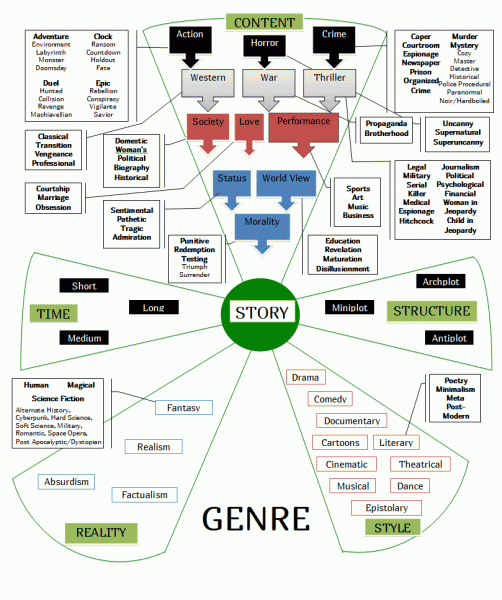
One of the most interesting aspect of Coyne’s analysis, for me, is breaking story structure down into three types: archplot (the standard), miniplot (mostly literary), and antiplot (experimental).
Having been a fan of Joseph Campbell’s Hero with a Thousand Faces since I was 16 — a very long time ago — , I assumed that archplot was really the only structure. But try to analyze an Alice Monroe story in this way! It simply doesn’t work. Her stories follow Coyne’s miniplot model. This makes sense.
Too, I’ve sometimes wondered if the archplot “quest” story model wasn’t basically male, wondered if there was a female alternative. (A thought to tuck away for future pondering.)
I’ve an important thing to decide about the novel I’m writing: What genre is it? It’s a coming-0f-age novel, true, but it’s also a romance. As such, it’s missing some key scenes — which helps explain what my editors have been saying.
I’ll be writing more on The Story Grid in follow-up posts, but for now, it’s time to crawl back into that swamp (the WIP).
by Sandra Gulland | Oct 2, 2011 | Adventures of a Writing Life, The Shadow Queen, Work in Process (WIP) |

Canadian Thanksgiving is coming — a big, glorious dinner for over twenty friends and family at our house — and then we begin our winter transition to Mexico.
It’s not easy moving an office back and forth. Or rather, I should say: it’s not easy for a historical novelist.
I’ve begun to give thought to which reference books to take with me. I’ve a stack of books I brought back with me from Mexico in the spring — still untouched.
How many will I really need? The Net (Books Google), and the fact that many books are now available to me on iPad, have changed the way I research. Even so, I will inevitably take a small suitcase—a very heavy small suitcase—filled with notes, papers and books. I do it every year, and every year the decisions about what stays and what goes torments me.
But the main thing I must do — before next weekend, I pray — is finish draft 5.2 of The Next Novel. I will print it out in Mexico, and read/edit it there. And then — by grace of the muses — I plan to have it ready to send to my agent, Jackie Kaiser, by the end of October.
Enormous Changes at the Last Minute: I think often of the title of Grace Paley’s novel, for it seems to capture my writing process (every time). I’ve a main character gradually, ever so gradually, coming into focus. I’ve entire chapters that need to be created to fill gaping holes in the reconstruction. The change from 3rd person to 1st not long ago seems easy by comparison.
In moaning to my writers’ group, poet Jenifer McVaugh said, “You’ve got everything. You’re just missing the heart of the story.”
Exactly. That’s what the process of writing a novel is about: finding the (damned) heart of the story. And it never, at least for me, seems to come early on.
Novelists out there: what is your process? Is there any way to avoid this somewhat frantic scramble?
And one more question: What do you think of the title This Bright Darkness?
{Image above: view from my office window.}













